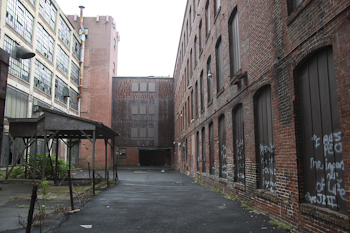 The aborted attempts at progress within the ATP and Palmer buildings in Ansonia are eerily apparent on a tour of the unused space.
The aborted attempts at progress within the ATP and Palmer buildings in Ansonia are eerily apparent on a tour of the unused space.
On the fourth floor of the Palmer Building, a former factory at 153 Main St., 12 unfinished shower stalls are littered with cigarette butts, almost 25 years after being installed for what was supposed to be a fitness center.
One level down, a pigeon carcass rots amid piles of bird droppings and random construction debris in an otherwise empty warehouse space.
In the adjoining ATP Building at 497 East Main St., former business owners abandoned hats and sewing machines, as if the building was evacuated quickly. Dozens of office chairs sit waiting for use in a make-shift city storage room. And paint peels off a brick wall in an open, sunny office space.
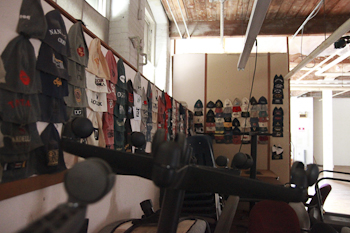 The odd remnants are reminders of plans that failed to come to fruition for the city-owned buildings in the heart of downtown.
The odd remnants are reminders of plans that failed to come to fruition for the city-owned buildings in the heart of downtown.
Now, as the national economy begins its slow recovery, the city is prepping for yet another effort to sell the buildings.
“I have had the same three developers who keep returning to the building,” said Shelia O’Malley, Ansonia’s economic development director. “To me that indicates that they are very serious in bidding.”
O’Malley expects to have a request for proposals ready for bids late this year or early next year.
But the public’s expectations for the property might not be as optimistic. In Derby, the next town over, where O’Malley previously worked, a long-promised downtown redevelopment zone remains a dream.
In Seymour, Tri-Town Plaza remains woefully undeveloped.
But the ATP and Palmer buildings sit as sort of the grandfather of stalled Valley revitalization projects.
General Background
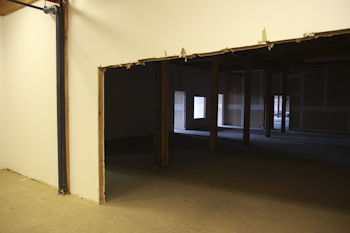 Ansonia has owned the two buildings — a combined 99,900 square feet encompassing the city block between East Main Street, Kingston Street and Main Street — since the 1980s.
Ansonia has owned the two buildings — a combined 99,900 square feet encompassing the city block between East Main Street, Kingston Street and Main Street — since the 1980s.
City officials have been trying, mostly unsuccessfully, to figure out what to do with the properties ever since.
A developer bought the Palmer Building from the city in 1989, but the city bought it back in 1994 after what some city documents describe as a legal battle with the owner. A complete picture of the history is hard to come because the files are missing from the city archives.
But the first two floors of the Palmer Building have been consistently occupied since the late 1990s, with the Doyle Senior Center and doctors offices.
The first floor of the ATP building was recently used as storage space for a local antiques shop, but is currently empty.
The rest of the space within the two buildings sits empty — and is in need of serious cleaning and updating.
Past plans for the space reads like a who’s who of development trends:
- An “incubator” office area for start-up companies
- Artists lofts
- A fitness center
- City offices
- A community college annex
- Upscale condominiums
- More artists lofts
The plans change as new studies recommended new ways to attract people downtown and as trends in development change.
“Technology has changed,” said Peter Burns, who was the executive director of the Ansonia Redevelopment Agency from 1969 to the late 1970s. “Industries change and therefore use of buildings has to change.”
Article continues after photo gallery.
“Ansonia’s been looking at what’s the better mouse trap,” said James Ryan, the former head of the Ansonia Redevelopment Agency, and the current executive director of the Shelton Economic Development Corporation.
Several big steps have been taken. Money has been spent.
New elevators were installed in both buildings to allow access for any type of business. The first and second floor of the Palmer Building were renovated and subdivided.
And, most importantly, the city got clearance that all brownfields were cleaned up in 2011. That helps the city target a developer who might want to use the properties for non-industrial uses.
That “incremental process” is how these old buildings are redeveloped, according to Ryan, who has overseen the same process for several old factory buildings in Shelton.
“It really is cobbling the money together,” Ryan said.
A Promising Start
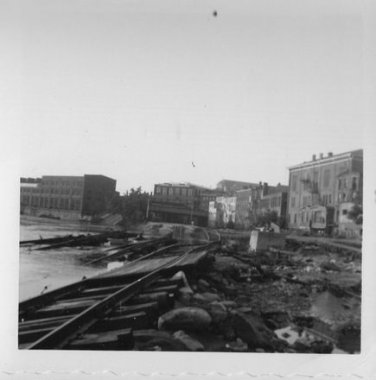 The Ansonia Redevelopment Agency was created in the late 1950s to help the city apply for and administer federal and state grants for property redevelopment after the Flood of 1955.
The Ansonia Redevelopment Agency was created in the late 1950s to help the city apply for and administer federal and state grants for property redevelopment after the Flood of 1955.
Through the agency, Ansonia started buying up downtown properties and finding local business owners to purchase them for cheap and fix them up, according to Burns. The redevelopment stretched as far as the Olson Drive housing and to the “Ansonia Mall,” where Big Y is now located.
New roads were created. Old buildings were torn down. The face of downtown began to dramatically change from its industrial roots. The development continued on into the 1980s, when the city first acquired the ATP and Palmer buildings.
The plan was to sell the Palmer Building to a developer, and rent out space in the ATP building.
In the early 1990s, New England Cap Co. set up shop making hats. And Val. St. Lambert, an “importer of crystal” according to building records, set up a warehouse and office on the fourth floor.
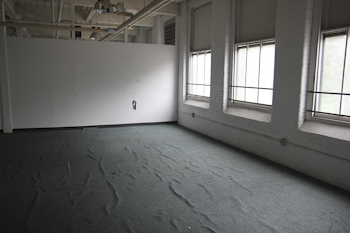 An alternative school called the Housatonic Children Center and a work training program for people with disabilities called UCP Special Needs also eventually opened in spacious reclaimed industrial space in the ATP building.
An alternative school called the Housatonic Children Center and a work training program for people with disabilities called UCP Special Needs also eventually opened in spacious reclaimed industrial space in the ATP building.
“We were able to get the ATP building fully rented,” said Florence Villano, who was the executive director of the Ansonia Redevelopment Agency during the early 1990s.
And in 1989, the city found a buyer for the Palmer Building on Main Street.
A November press release from the state Department of Economic Development announced that Wild Bills Inc. would open its corporate headquarters in Ansonia, bringing dozens of jobs and helping the company expand to 12 retail stores in Connecticut, New York and New Jersey.
But …
The honeymoon with Wild Bills only lasted a few months.
The owners were three brothers, though most of the records are in Brian Goldwitz’s name. Calls to a number on file for Goldwitz were not answered.
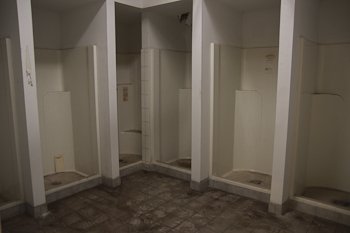 The company sold clothes factory-outlet style out of the first floor of the building. Their building permit on file from March 1990 reads like a circular advertisement, promising a “factory outlet store. Great Price. Great Fashion. Up to 60 percent off, everyday.”
The company sold clothes factory-outlet style out of the first floor of the building. Their building permit on file from March 1990 reads like a circular advertisement, promising a “factory outlet store. Great Price. Great Fashion. Up to 60 percent off, everyday.”
Behind the scenes, though, Wild Bills was preparing to file for bankruptcy and the brothers were fighting about money, according to legal paperwork on file at the city clerk’s office.
Three months later, the city was at odds with Goldwitz, who was apparently trying to build a fitness center within his building.
The city’s building department issued a cease and desist order on work for the fitness center on the fourth floor because no authorized the work.
The work stopped mid construction and sits today frozen in time.
Bathroom stalls have doors, but no toilets. Tanning rooms are sheet-rocked but otherwise empty. The reception area was even painted a color similar to Sherwin Williams’ “greige.”
“You do not have the proper approvals or permits to proceed with what you are doing,” Edward Liskiewicz, of the city’s building department, wrote on June 26, 1990.
Several proposals for the fitness center are filed in the building department, some dated prior to the June cease and desist letter.
A July letter from Wild Bill’s attorney argued that the company was in compliance, and proposing a use that was permitted in the then-commercial zone.
“Any potential disagreements that Mr. Goldwitz has with the Ansonia Redevelopment Agency should not enter into a decision on an application for a building permit for a permitted use with that zone,” wrote John Sponheimer on July 20, 1990.
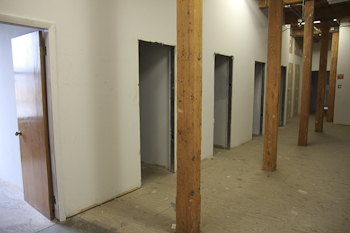 After Wild Bills closed its doors in May of 1992, the problems continued.
After Wild Bills closed its doors in May of 1992, the problems continued.
Goldwitz was using the site for a new company, called “The Cover-It Manufacturing Company,” and neighbors in the Farrell Processing Lab and the ATP building complained about the work.
The city issued another cease and desist order, this time for using the space to assemble “metallic tubing members to form various fabric-covered structures” — a use that was not what the city originally approved.
The neighbors said the company was storing large metal poles in the courtyard, blocking fire exits and blighting the property.
Stalled Efforts
After the city bought the property back in 1994, it opened the Doyle Senior Center on the first floor, and rented office space on the second floor to two doctors, who remain in the building.
But other plans for the property didn’t have the same holding power.
Documents on file with the building department show efforts to start an “artists colony” in the Palmer Building in 2002.
The C R Gibson Company proposed opening an “art and design” office that would employ four full-time graphic artists and “be an anchor” for other arts-related industry in the building.
An online marketing firm and nursing company also sought information for moving to the Palmer Building.
“It just didn’t work out. It was really sad,” said Carol Forcier, who used to work in the Ansonia Redevelopment Agency office, and moved to City Hall when the agency was dissolved during Valentine’s term.
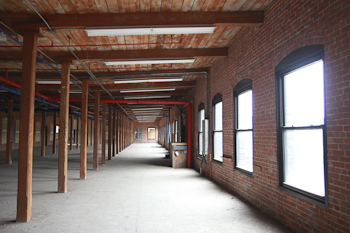 Forcier couldn’t pin point the reason, except to say the city was afraid to do it.
Forcier couldn’t pin point the reason, except to say the city was afraid to do it.
“When it came actual time, it never happened,” Forcier said.
Around the same time, city leaders decided to get out of the landlord business and put the buildings up for sale. By 2008, it had reached an agreement with Duke Realty, which wanted to buy the buildings for $1.5 million and build condos in the space.
But four years later, that deal was also dead.
City leaders often blamed the economy — which tanked nation-wide in 2008 and 2009.
A search for a new developer last year brought zero interested parties.
More of the Same?
Ansonia’s new corporation counsel, John Marini, blamed a small-town mentality on the city’s failure to attract a viable developer to the property. The city has to think big.
“We had to expand the scope of search for investors,” Marini said. “The search was always limited to the local pond, if you will, and we always got more of the same.”
Marini and O’Malley say this time the redevelopment effort will be different.
When interviewed in June about the buildings, O’Malley had targeted August as the time she wanted to put out a new request for proposals. But, by mid August, that date was moved back to late fall, or early winter.
“We are still looking at the RFP, tweaking it,” O’Malley said.
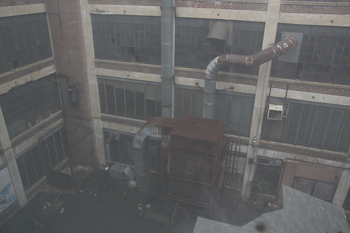 The delay?
The delay?
O’Malley is now working with the new owner of the Farrell Processing Lab that shares a courtyard with the ATP and Palmer buildings to see if he will be willing to sell to the same developer that buys the city property.
The owner, Moustapha Diakhate, purchased the property in January 2013. Development plans for the site have never been announced, or at least have never been made public.
The properties — Diakhate’s and the city’s — complement each other, O’Malley said.
“It would be more profitable if you have more space, if that building were included in there,” O’Malley said. “I can’t stress enough the fact that you need to plan. And you need to look at these sites as to why are they still here. Why have they not been developed? They all have issues.”